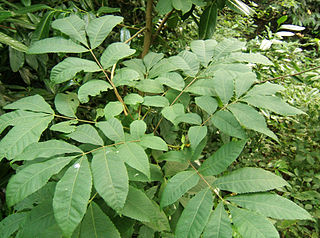
Forsythia, is a genus of flowering plants in the olive family Oleaceae. There are about 11 species, mostly native to eastern Asia, but one native to southeastern Europe. Forsythia – also one of the plant's common names – is named after William Forsyth.

Carya ovata, the shagbark hickory, is a common hickory in the Eastern United States and southeast Canada. It is a large, deciduous tree, growing well over 100 ft (30 m) tall, and can live more than 350 years. The tallest measured shagbark, located in Savage Gulf, Tennessee, is over 150 ft (46 m) tall. Mature shagbarks are easy to recognize because, as their name implies, they have shaggy bark. This characteristic is, however, only found on mature trees; young specimens have smooth bark.

The Circaea, or enchanter's nightshades, are a genus of flowering plants in the evening primrose family Onagraceae. About two dozen taxa have been described, including eight species. Plants of the genus occur throughout the temperate and boreal forests of the Northern Hemisphere. Three taxa occur in North America: Circaea alpina, Circaea canadensis, and the hybrid Circaea × sterilis. The generic name Circaea refers to the enchantress Circe from Greek mythology who is said to have used the herb as a charm.

Carya cordiformis, the bitternut hickory, also called bitternut or swamp hickory, is a large pecan hickory with commercial stands located mostly north of the other pecan hickories. Bitternut hickory is cut and sold in mixture with the true hickories. It is the shortest-lived of the hickories, living to about 200 years.

Nepenthes ovata is a tropical pitcher plant endemic to Sumatra. The specific epithet ovata is Latin for "ovate" and refers to the shape of the lower pitchers.

Rhus ovata, commonly known as sugar bush or sugar sumac, is a shrub or small tree found growing in the canyons and slopes of the chaparral and related ecosystems in Southern California, Arizona, Baja California and Baja California Sur. It is a long lived-plant, up to 100 years, and has dense evergreen foliage that make it conspicuous. It is closely related to and hybridizes with the lemonade sumac.

Neottia ovata, the common twayblade or eggleaf twayblade, is a terrestrial orchid widespread across much of Europe and Asia

Nepenthes flava is a tropical pitcher plant endemic to northern Sumatra, where it grows in montane forest at 1800–2200 m above sea level.

Circaea lutetiana, known as broad-leaved enchanter's nightshade, is a plant in the evening primrose family, Onagraceae.

Crassula ovata, commonly known as jade plant, lucky plant, money plant or money tree, is a succulent plant with small pink or white flowers that is native to the KwaZulu-Natal and Eastern Cape provinces of South Africa, and Mozambique; it is common as a houseplant worldwide. Much of its popularity stems from the low levels of care needed; the jade plant requires little water and can survive in most indoor conditions. It is sometimes referred to as the money tree; however, Pachira aquatica also has this nickname.

Circaea alpina, commonly called alpine enchanter's nightshade or small enchanter's nightshade, is a 10–30 cm tall perennial herb found in cool forests of the Northern Hemisphere.

Circaea canadensis, known as eastern enchanter's nightshade, Canada enchanter's nightshade, broad-leaved enchanter's nightshade, is a perennial herbaceous plant found in forests of eastern North America. It is very similar to its sister species, Circaea lutetiana, and was formerly considered conspecific.
Circaea × intermedia is a hybrid of flowering plants in the evening primrose family Onagraceae. The parents of the hybrid are Circaea alpina and Circaea lutetiana.
Circaea × sterilis is a hybrid of flowering plants in the evening primrose family Onagraceae. The parents of the hybrid are Circaea alpina and Circaea canadensis.
Circaea × decipiens is a hybrid of flowering plants in the evening primrose family Onagraceae. The parents of the hybrid are Circaea erubescens and Circaea canadensis subsp. quadrisulcata.
Circaea × mentiens is a hybrid of flowering plants in the evening primrose family Onagraceae. The parents of the hybrid are Circaea alpina and Circaea erubescens.
Circaea × skvortsovii is a hybrid of flowering plants in the evening primrose family Onagraceae. The parents of the hybrid are Circaea cordata and Circaea canadensis subsp. quadrisulcata.
Circaea × dubia is a hybrid of flowering plants in the evening primrose family Onagraceae. The parents of the hybrid are Circaea cordata and Circaea erubescens.
Circaea × taronensis is a hybrid of flowering plants in the evening primrose family Onagraceae. The parents of the hybrid are Circaea alpina subsp. imaicola and Circaea cordata.











